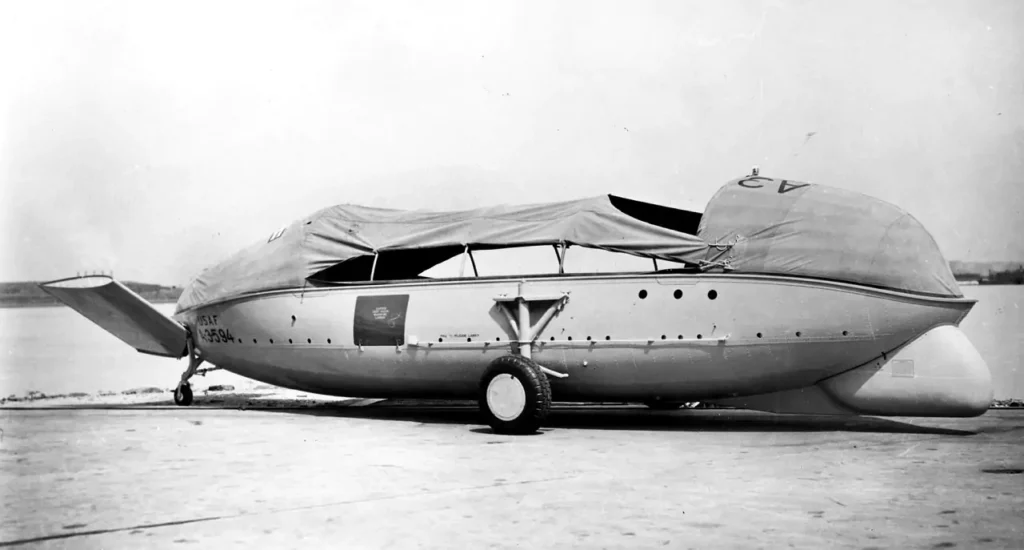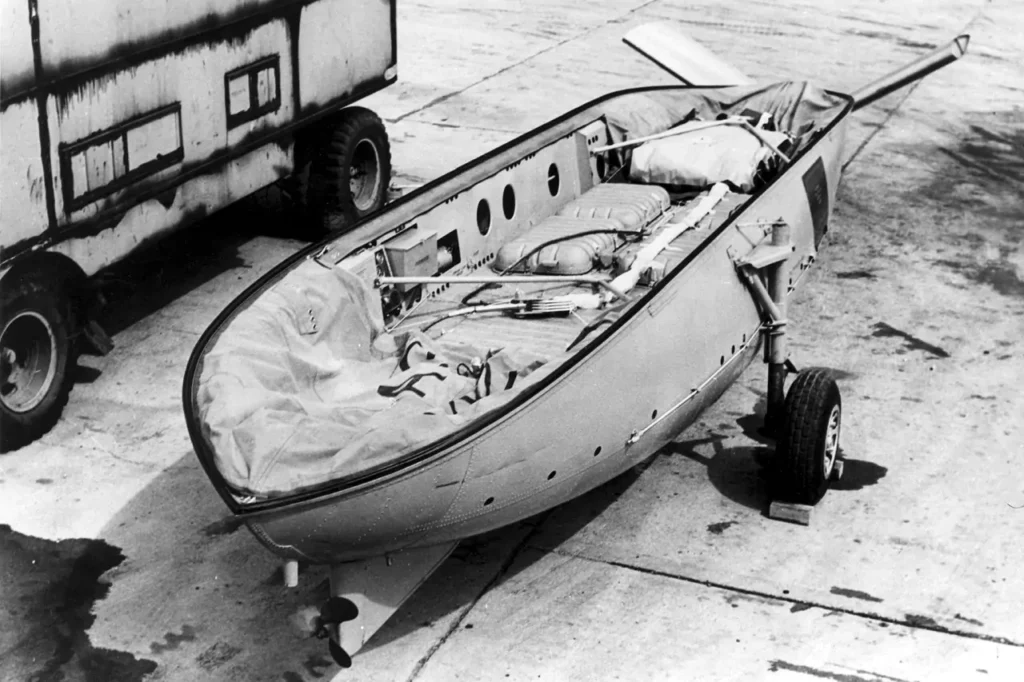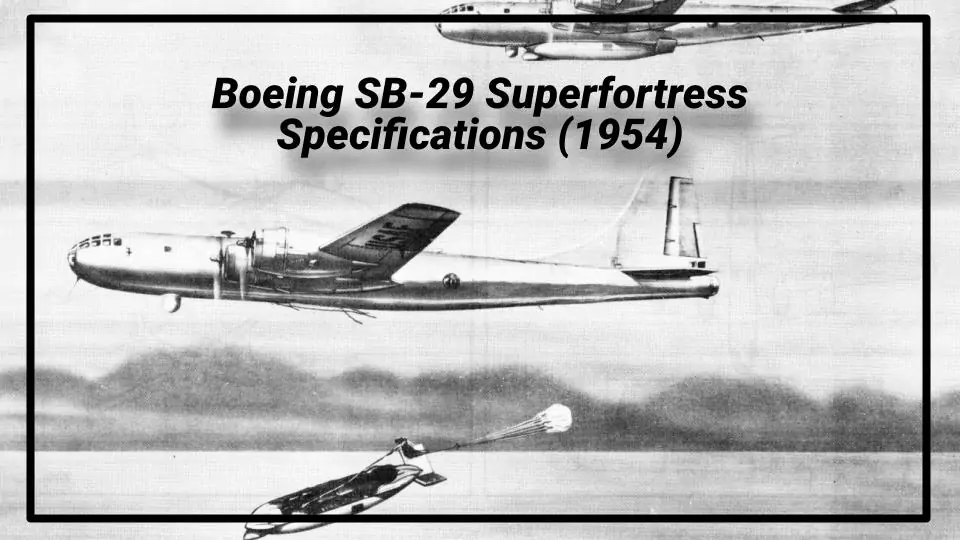
Mission
The main mission of the SB-29 was air search and rescue of personnel stranded in water, primarily to provide rescue support for units flying long distances over water. This objective was achieved using radar and a disposable A-3 lifeboat.
The SB-29s served in the Korean War, carrying A-3 lifeboats over the Yellow Sea and the Sea of Japan. During B-29 bombing missions, the SB-29s would maintain a position off the enemy coast and search for downed aircrews. Upon locating the stranded crews, the SB-29 would deploy an EDO A-3 rescue boat, with its descent slowed by parachutes.
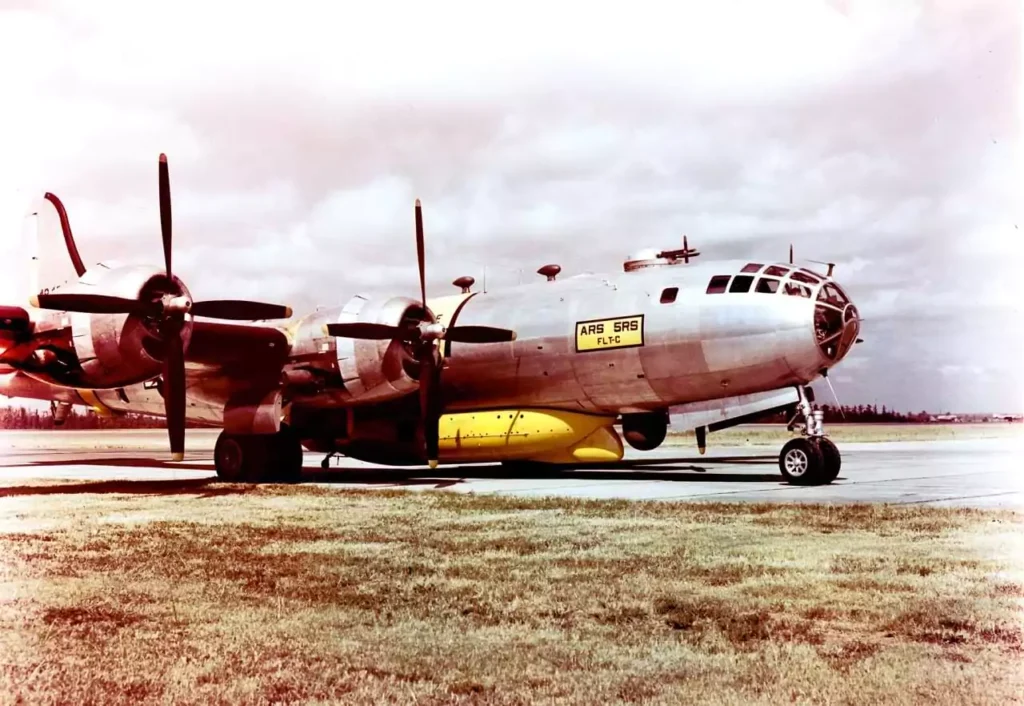
Development
The success of the B-17H later referred to as the SB-17 Dumbo, prompted experimentation with a similar air-sea rescue aircraft based on the B-29 as early as 1944. The Superfortress’s extended range, increased lift capacity, and advanced features were all deemed improvements over the SB-17’s capabilities.
In 1949, a series of conversions for a select number of SB-29 aircraft commenced. According to recent research by Robert A. Mann, 25 such aircraft were primarily converted at Tinker Air Force Base.
Differences with B-29
The conversion from the Boeing B-29 to the SB-29 resulted in three distinct changes not found in the production B-29s:
- First, the AN/APQ-13 radome was relocated from between the bomb bays to the position typically occupied by the lower forward turret.
- Second, the 30-foot, droppable Edo A-3 lifeboat was mounted externally to the bomb bays.
- Lastly, the radio operator’s position was moved from the right-rear corner of the forward compartment to the rear pressurized compartment.
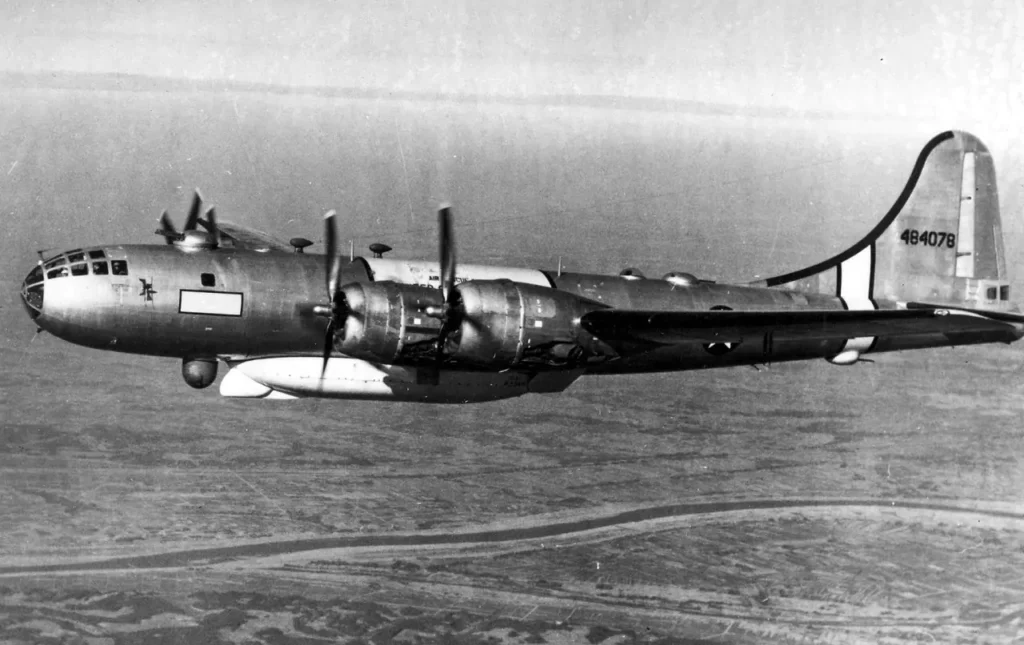
Despite these modifications, the remaining armament, which included the upper forward turret, two aft turrets, and tail guns, remained in the aircraft and operational.
Dimensions and Weights
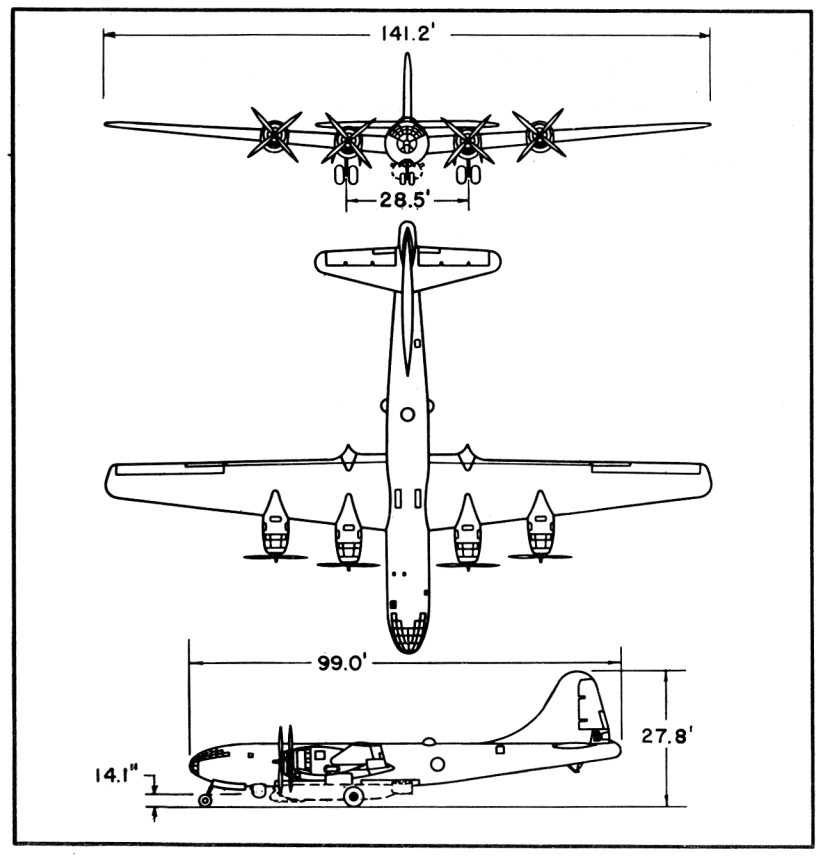
| DIMENSIONS | US | Metric |
|---|---|---|
| Wing | ||
| 141.2 ft | 43 m | |
| 4° | 4° | |
| 4°29'23" | 4°29'23" | |
| 7°1'26" | 7°1'26" | |
| 1720 ft2 | 159.8 m2 | |
| 11.5 | 11.5 | |
| Boeing 117 | Boeing 117 | |
| 154.41 | 47.1 m | |
| Length | 99 ft | 30.2 m |
| Height | 27.8 ft | 8.5 m |
| Tread | 28.5 ft | 8.7 m |
| Prop. Grd Clearance | 1.3 ft | 0.4 m |
| WEIGHTS | ||
| Loading | ||
| 68,350 lbs | 31.003 kg | |
| 72,616 lbs | 32.938 kg | |
| Operating | ||
| 120,000 lbs | 54.431 kg | |
| 99,410 lbs | 45.092 kg | |
| 120,662 lbs | 54.731 kg | |
| 120,662 lbs | 54.731 kg |
(E) Estimated
(*) For basic mission
(1) Limited by performance
(2) Limited by gear strength
Engines
| Attribute | Value |
|---|---|
| POWER PLANT | |
| (4) R-3350-57 or-83 | |
| Curtiss - Wright Corp., Wright Aeronautical Corp. Division | |
| .787-C | |
| 1 stg, 1 spd | |
| B-11 or B-31 | |
| General Electric Co. | |
| 0.35 | |
| PROPELLER | |
| United Aircraft Corp., Hamilton Standard Propeller Division | |
| 6521A-6 | |
| C.S., Full-Feathering, Hydromatic | |
| 4 | |
| 16' 7" (5 m) | |
| ENGINE RATINGS | |
| 2200/2800rpm | |
| 2200/2600rpm/2500ft | |
| 2000/2400rpm/4000ft |
Electronics
| Equipment | US Designation |
|---|---|
| UHF Command | AN/ARC-27 |
| VHF Command | AN/ARC-3 |
| Liaison | AN/ARC-8 |
| Interphone | AN/AIC-2A |
| Radio Compass | AN/ARN-7 |
| Marker Beacon | RC-193A |
| Homing Adapter | AN/ARA-8 |
| Glide Path | AN/ARN-5B |
| Radio Altimeter | SCR-718C |
| Radio Altimeter | AN/APN-1 |
| Interrogator | SCR-729 |
| IFF | SCR-695B |
| Loran | AN/APN-9 |
| Search Radar | AN/APQ-13A |
| Pulse Doppler | AN/APA-52 |
| Remote Control | AN/URW-3 |
Crew

The SB-29 had a normal crew of 11 that consisted of:
- Pilot
- Co-pilot
- Flight engineer
- Navigator
- Bombardier
- Remote control turret operator
- Radar operator
- (2) Radio operators
- Left scanner
- Right scanner
EDO A-3 lifeboat
The A-3 Airborne Lifeboat, or EDO Model 98, was created by the EDO Corporation in 1947 for the United States Air Force as a successor to the Higgins Industries A-1 lifeboat.
The lifeboat measured 30.05 feet in length, weighed 2,736 pounds when fully loaded, and could rescue up to 15 survivors. Powered by a Meteor 20 gasoline engine, it reached speeds of 8 knots and was dropped from the SB-29 using a 100-foot parachute.
The A-3 lifeboat featured various safety and functional components, such as a sail, a self-draining cockpit, and 20 watertight compartments. It was also equipped with bow and stern self-righting chambers that inflated automatically upon release, ensuring the boat was self-righting.
As it descended from 800 to 5,000 feet, the lifeboat’s 100-foot parachute helped stabilize its flight characteristics. The boat’s propellers and rudder were protected by metal guards, and the parachute was designed to reduce impact shock when the boat hit the water. The parachute also triggered valves to fill self-righting chambers with carbon dioxide and activated a white electric beacon for nighttime visibility.
Although not luxurious, the A-3 lifeboat was equipped with essential survival gear for aircrews in distress at sea. It featured ladders for easy boarding, a waterproof plexiglass shell to protect the engine, and storage for warm clothes, food, medical supplies, and other provisions for a crew of 15.
The lifeboat also included a gasoline-operated distiller to convert saltwater into fresh drinking water, as well as other essential equipment such as a sea anchor, fire extinguisher, compass, navigational aids, bilge pump, heaving quoit, tool kit, salt water soap, and a cockpit compartment heater.
| Feature/Equipment | Description |
|---|---|
| US Designation | A-3 Airborne Lifeboat |
| Model | EDO Model 98 |
| Manufacturer | EDO Corporation, College Point, Long Island, New York |
| Overall Length | 30.05 feet |
| Weight (fully loaded) | 2,736 pounds |
| Passenger Capacity | 15 survivors |
| Material | Aluminum alloy |
| Engine | Four-cylinder, four-stroke Meteor 20 gasoline engine by Red Wing Motor Company |
| Propeller | Ailsa Craig propeller |
| Speed | 8 knots under calm water conditions |
| Fuel Capacity | 100 US gallons |
| Range | 500 nm |
| Parachute | Single 100-foot diameter parachute, 7,857 square feet of nylon |
| Self-Righting | Equipped with bow and stern rubberized fabric self-righting chambers |
| Boarding Ladder | Included |
| Provisions | Food, water, and radio gear for rescued individuals |
| Protective Features | Metal guards for propellers and rudder; waterproof plexiglass shell for engine |
| Navigational Equipment | Compass, navigational aids |
| Survival Equipment | Warm clothes, medical supplies, sea anchor, fire extinguisher, bilge pump, heaving quoit, tool kit, salt water soap |
| Additional Features | Gasoline-operated distiller for fresh water; cockpit compartment heater; self-draining cockpit; 20 watertight compartments |
Fuel system

| Location | No. Tanks | Gals | Liters |
|---|---|---|---|
| Wing, outbond* | 2 | 2640 | 9993 |
| Wing, inbound* | 2 | 2830 | 10713 |
| Wing, center* | 1 | 1333 | 5046 |
| Total | 6803 | 25752 |
(*) Self Sealing tanks
Bombs
Bombs racks were installed but bombing capacities were not considered
Guns
During the conversion to SB-29 the upper forward turret, two aft turrets, and tail guns, remained in the aircraft. However, the B-29B Superfortress Standard Aircraft Characteristics of 1954 indicates that the Air Force removed all the guns.
Performance
The basic performance of the SB-29 was the following:
Combat radius
1685 nm
with an A-3 lifeboat at 172 knots avg. in 19.80 hours
Combat range
——–
Combat speed
239 kn
at 10,000 ft alt, max power
Maximum speed
334 kn
at 33,300 ft alt, max power
Climb
730/1345
fpm sea level, take-off weight normal power
/fpm sea level, combat weight max power
Ceiling
32,800/
35,600 ft
100 fpm, take-off weight, normal power
/500 fpm, combat weight max power
Loading and Performance
| Conditions | Basic mission | Boat dropped | Ferry range | |||
|---|---|---|---|---|---|---|
| TAKE-OFF WEIGHT | 120,662 lb | 54.731 kg | 120,662 lb | 54.731 kg | 120,662 lb | 54.731 kg |
| 40,818 lb | 18.515 kg | 40,818 lb | 18.515 kg | 40,818 lb | 18.515 kg | |
| 3,491 lb(4) | 1.583 kg | 3,491 lb | 1.583 kg | 3,491 lb(4) | 1.583 kg | |
| 70.2 lb/sq ft | 342.7 kg/m2 | 70.2 lb/sq ft | 342.7 kg/m2 | 70.2 lb/sq ft | 342.7 kg/m2 | |
| 95.7 kn | 177 km/h | 95.7 kn | 177 km/h | 95.7 kn | 177 km/h | |
| 3,475 ft | 1.059 m | 3,475 ft | 1.059 m | 3,475 ft | 1.059 m | |
| 5,075 ft | 1.547 m | 5,075 ft | 1.547 m | 5,075 ft | 1.547 m | |
| 730 fpm | 223 m/min | 730 fpm | 223 m/min | 730 fpm | 223 m/min | |
| 435 fpm | 133 m/min | 435 fpm | 133 m/min | 435 fpm | 133 m/min | |
| 15.0 min | 15.0 min | 15.0 min | ||||
| 35.0 min | 35.0 min | 35.0 min | ||||
| 32,800 ft | 9.997 m | 32,800 ft | 9.997 m | 32,800 ft | 9.997 m | |
| 21,600 ft | 6.584 m | 21,600 ft | 6.584 m | 21,600 ft | 6.584 m | |
| COMBAT RANGE | 3,445 n.mi | 6380 km | ||||
| COMBAT RADIUS | 1,685 n.mi | 3.121 km | 1,759 n.mi | 3.258 km | ||
| 172 kn | 319 km/h | 173 kn | 320 km/h | 173 kn | 320 km/h | |
| 5,000 ft | 1.524 m | 5,000 ft | 1.524 m | 5,000 ft | 1.524 m | |
| Sea level | Sea level | |||||
| 5,000 ft | 1.524 m | 5,000 ft | 1.524 m | 5,000 ft | 1.524 m | |
| 19.8 hr | 20.6 hr | 20.0 hr | ||||
| COMBAT WEIGHT | 99,410 lb | 45.092 kg | 95,119 lb | 43.145 kg | 82,579 lb | 37.457 kg |
| Sea level | Sea level | 5,000 ft | 1.524 m | |||
| 239 kn | 443 km/h | 250 kn | 463 km/h | 254 kn | 470 km/h | |
| 1,345 fpm | 410 m/min | 1,520 fpm | 463 m/min | 1,780 fpm | 543 m/min | |
| 35,600 ft | 10.851 m | 37,300 ft | 11.369 m | 39,500 ft | 12.040 m | |
| 38,600 ft | 11.765 m | 39,700 ft | 12.101 m | 42,600 ft | 12.984 m | |
| 32,400 ft | 9.876 m | 36,800 ft | 11.217 m | 38,800 ft | 11.826 m | |
| 1,345 fpm | 410 m/min | 1,520 fpm | 463 m/min | 1,850 fpm | 564 m/min | |
| 334 kn/33,300 ft | 619 km/h /10.150 m | 349 kn/33,300 ft | 646 km/h /10.150 m | 344 kn/33,300 ft | 637 km/h /10.150 m | |
| 306 kn | 567 km/h | 318 kn | 589 km/h | 313 kn | 580 km/h | |
| LANDING WEIGHT | 82,579 lb | 37.457 kg | 79,037 lb | 35.851 kg | 82,579 lb | 37.457 kg |
| 2,200 ft | 671 m | 2,120 ft | 646 m | 2,200 ft | 671 m | |
| 2,950 ft | 899 m | 2,840 ft | 866 m | 2,950 ft | 899 m | |
Further reading
- Boeing B-29 Superfortress Specifications (1950)
- Boeing B-29A Superfortress Specifications (1950)
- Boeing B-29B Superfortress Specifications (1950)
- Boeing KB-29P Superfortress Specifications (1951)
- Tupolev Tu-4 Standard Specification & Performance
- Boeing B-29 Superfortress Facts: 11 things to know
Bibliography
- B-29 Superfortress in detail & scale, Part 2 by Alwyn T. Lloyd
- The B-29 Superfortress: A Comprehensive Registry of the Planes and Their Missions by e Robert A. Mann
- SB-29 Superfortress Standard Aircraft Characteristics 15-JUN-1954, Air Materiel Command, U.S. Air Force
- “Operation Splash” by Frank W. Penniman, Life of the Soldier and the Airman, U.S. Army, 1948
